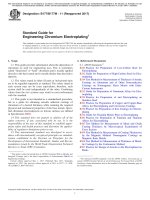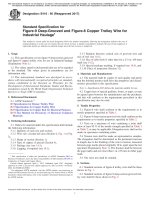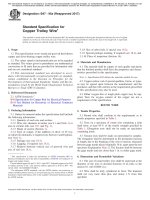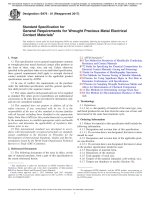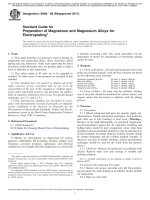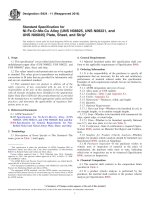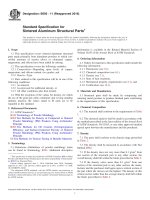Astm b 8 11 (2017)
Bạn đang xem bản rút gọn của tài liệu. Xem và tải ngay bản đầy đủ của tài liệu tại đây (132.51 KB, 8 trang )
This international standard was developed in accordance with internationally recognized principles on standardization established in the Decision on Principles for the
Development of International Standards, Guides and Recommendations issued by the World Trade Organization Technical Barriers to Trade (TBT) Committee.
Designation: B8 − 11 (Reapproved 2017)
Standard Specification for
Concentric-Lay-Stranded Copper Conductors, Hard,
Medium-Hard, or Soft1
This standard is issued under the fixed designation B8; the number immediately following the designation indicates the year of original
adoption or, in the case of revision, the year of last revision. A number in parentheses indicates the year of last reapproval. A superscript
epsilon (´) indicates an editorial change since the last revision or reapproval.
This standard has been approved for use by agencies of the U.S. Department of Defense.
2. Referenced Documents
1. Scope
2.1 ASTM Standards:2
B1 Specification for Hard-Drawn Copper Wire
B2 Specification for Medium-Hard-Drawn Copper Wire
B3 Specification for Soft or Annealed Copper Wire
B33 Specification for Tin-Coated Soft or Annealed Copper
Wire for Electrical Purposes
B172 Specification for Rope-Lay-Stranded Copper Conductors Having Bunch-Stranded Members, for Electrical Conductors
B173 Specification for Rope-Lay-Stranded Copper Conductors Having Concentric-Stranded Members, for Electrical
Conductors
B174 Specification for Bunch-Stranded Copper Conductors
for Electrical Conductors
B189 Specification for Lead-Coated and Lead-Alloy-Coated
Soft Copper Wire for Electrical Purposes
B193 Test Method for Resistivity of Electrical Conductor
Materials
B246 Specification for Tinned Hard-Drawn and MediumHard-Drawn Copper Wire for Electrical Purposes
B263 Test Method for Determination of Cross-Sectional
Area of Stranded Conductors
B354 Terminology Relating to Uninsulated Metallic Electrical Conductors
B787/B787M Specification for 19 Wire Combination
Unilay-Stranded Copper Conductors for Subsequent Insulation
1.1 This specification covers bare concentric-lay-stranded
conductors made from round copper wires, either uncoated or
coated with tin, lead, or lead alloy for general use for electrical
purposes. These conductors shall be constructed with a central
core surrounded by one or more layers of helically laid wires.
NOTE 1—This specification also permits conductors for use as covered
or insulated electrical conductors.
NOTE 2—Sealed conductors, that are intended to prevent longitudinal
water propagation and are further covered/insulated, are also permitted
within the guidelines of this specification.
1.2 For the purposes of this specification, conductors are
classified as follows (Explanatory Note 1 and Note 2):
1.2.1 Class AA—For bare conductors usually used in overhead lines.
1.2.2 Class A—For conductors to be covered with weatherresistant (weather-proof), slow-burning materials, and for bare
conductors where greater flexibility than is afforded by Class
AA is required.
1.2.3 Class B—For conductors to be insulated with various
materials such as rubber, paper, varnished cloth, and so forth,
and for the conductors indicated under Class A where greater
flexibility is required.
1.2.4 Class C and Class D—For conductors where greater
flexibility is required than is provided by Class B conductors.
1.3 The SI values for density are regarded as the standard.
For all other properties, the inch-pound values are to be
regarded as standard and the SI units may be approximate.
1.4 This international standard was developed in accordance with internationally recognized principles on standardization established in the Decision on Principles for the
Development of International Standards, Guides and Recommendations issued by the World Trade Organization Technical
Barriers to Trade (TBT) Committee.
3. Ordering Information
3.1 Orders for material under this specification shall include
the following information:
3.1.1 Quantity of each size and class,
3.1.2 Conductor size: circular-mil area or AWG (Section 6),
3.1.3 Class (see 1.2 and Table 1),
3.1.4 Temper (see 13.2),
1
This specification is under the jurisdiction of ASTM Committee B01 on
Electrical Conductors and is the direct responsibility of Subcommittee B01.04 on
Conductors of Copper and Copper Alloys.
Current edition approved April 1, 2017. Published April 2017. Originally
approved in 1915. Last previous edition approved in 2011 as B8 – 11. DOI:
10.1520/B0008-11R17.
2
For referenced ASTM standards, visit the ASTM website, www.astm.org, or
contact ASTM Customer Service at For Annual Book of ASTM
Standards volume information, refer to the standard’s Document Summary page on
the ASTM website.
Copyright © ASTM International, 100 Barr Harbor Drive, PO Box C700, West Conshohocken, PA 19428-2959. United States
1
B8 − 11 (2017)
TABLE 1 Construction Requirements of Concentric-Lay-Stranded Copper Conductors
Area of
Cross-Section,
cmil
Size,
American
Wire Gage
Class AA
Number of
Wires
Diameter of
Wires, mils
Class BA
Class A
Number of
Wires
Diameter of
Wires, mils
Class C
*5 000 000
...
...
...
169
172.0
217
151.8
271
135.8
4 500 000
...
...
...
169
163.2
217
144.0
271
128.9
4 000 000
...
...
...
169
153.8
217
135.8
271
121.5
3 500 000
...
...
...
127
166.0
169
143.9
217
127.0
*3 000 000
...
...
...
127
153.7
169
133.2
217
117.6
*2 500 000
...
...
...
91
165.7
127
140.3
169
121.6
*2 000 000
...
...
...
91
148.2
127
125.5
169
108.8
1 900 000
...
...
...
91
144.5
127
122.3
169
106.0
1 800 000
...
...
...
91
140.6
127
119.1
169
103.2
*1 750 000
...
...
...
91
138.7
127
117.4
169
101.8
1 700 000
...
...
...
91
136.7
127
115.7
169
100.3
1 600 000
...
...
...
91
132.6
127
112.2
169
97.3
*1 500 000
...
...
...
61
156.8
91
128.4
127
108.7
1 400 000
...
...
...
61
151.5
91
124.0
127
105.0
1 300 000
...
...
...
61
146.0
91
119.5
127
101.2
*1 250 000
...
...
...
61
143.1
91
117.2
127
99.2
1 200 000
...
...
...
61
140.3
91
114.8
127
97.2
1 100 000
...
...
...
61
134.3
91
109.9
127
93.1
*1 000 000
...
37
164.4
61
128.0
61
128.0
91
104.8
900 000
...
37
156.0
61
121.5
61
121.5
91
99.4
*800 000
...
37
147.0
61
114.5
61
114.5
91
93.8
*750 000
...
37
142.4
61
110.9
61
110.9
91
90.8
*700 000
...
37
137.5
61
107.1
61
107.1
91
87.7
650 000
...
37
132.5
61
103.2
61
103.2
91
84.5
*600 000
...
37
127.3
37
127.3
61
99.2
91
81.2
550 000
...
37
121.9
37
121.9
61
95.0
91
77.7
*500 000
...
19
162.2
37
116.2
37
116.2
61
90.5
450 000
...
19
153.9
37
110.3
37
110.3
61
85.9
*400 000
...
19
145.1
19
145.1
37
104.0
61
81.0
*350 000
...
12
170.8
19
135.7
37
97.3
61
75.7
*300 000
...
12
158.1
19
125.7
37
90.0
61
70.1
*250 000
...
12
144.3
19
114.7
37
82.2
61
64.0
*211 600
0000
7
173.9
7
173.9
19
105.5
37
75.6
*167 800
000
7
154.8
7
154.8
19
94.0
37
67.3
*133 100
00
7
137.9
7
137.9
19
83.7
37
60.0
*105 600
0
7
122.8
7
122.8
19
74.5
37
53.4
*83 690
1
3B
167.0
7
109.3
19
66.4
37
47.6
148.7
7
97.4
7
97.4
19
59.1
*66 360
2
3B
132.5
7
86.7
7
86.7
19
52.6
*52 620
3
3B
B
*41 740
4
3
118.0
7
77.2
7
77.2
19
46.9
*33 090
5
...
...
...
...
7
68.8
19
41.7
*26 240
6
...
...
...
...
7
61.2
19
37.2
*20 820
7
...
...
...
...
7
54.5
19
33.1
*16 510
8
...
...
...
...
7
48.6
19
29.5
*13 090
9
...
...
...
...
7
43.2
19
26.2
*10 380
10
...
...
...
...
7
38.5
19
23.4
*6 530
12
...
...
...
...
7
30.5
19
18.5
*4 110
14
...
...
...
...
7
24.2
19
14.7
*2 580
16
...
...
...
...
7
19.2
19
11.7
*1 620
18
...
...
...
...
7
15.2
19
9.2
*1 020
20
...
...
...
...
7
12.1
19
7.3
*640
22
...
...
...
...
7
9.6
19
5.8
*404
24
...
...
...
...
7
7.6
19
4.6
* The sizes of conductors that have been marked with an asterisk provide for one or more schedules of preferred series, and are commonly used
sizes not marked are given simply as a matter of reference and it is suggested that their use be discouraged.
A
B
Class D
Number of Diameter of Number of Diameter of Number of Diameter of
Wires
Wires, mils
Wires
Wires, mils
Wires
Wires, mils
271
135.8
271
128.9
271
121.5
271
113.6
271
105.2
217
107.3
217
96.0
217
93.6
217
91.1
217
89.8
217
88.5
217
85.9
169
94.2
169
91.0
169
87.7
169
86.0
169
84.3
169
80.7
127
88.7
127
84.2
127
79.4
127
76.8
127
74.2
127
71.5
127
68.7
127
65.8
91
74.1
91
70.3
91
66.3
91
62.0
91
57.4
91
52.4
61
58.9
61
52.4
61
46.7
61
41.6
61
37.0
37
42.4
37
37.7
37
33.6
37
29.9
37
26.6
37
23.7
37
21.1
37
18.8
37
16.7
37
13.3
37
10.5
...
...
...
...
...
...
...
...
...
...
in the industry. The
For unidirectional/unilay constructions the number of wires shown are minimum requirements.
Although Class AA conductors having three strands do not conform to the construction requirements of 1.1, they are listed in this table for convenience.
3.1.11 Place of inspection (see Section 14).
3.1.5 Whether coated or uncoated; if coated, designate type
of coating (see 13.1 and 13.2),
3.1.6 Details of special-purpose lays, if required (see 5.4),
3.1.7 When physical tests shall be made (see Sections 7 and
8),
3.1.8 Package size (see Section 15),
3.1.9 Lagging, if required (see section 15.2),
3.1.10 Special package marking, if required (see section
15.3), and
4. Joints
4.1 Welds and brazes may be made in rods or in wires prior
to final drawing. Joints may not be made in the finished wires
composing hard-drawn or medium-hard-drawn Class AA conductors of seven wires or less. In other conductors, welds and
2
B8 − 11 (2017)
TABLE 2 Minimum Distance Between Joints in the Completed Conductor
Number of Wires in
Conductor
3
7
12
19
20 to 36
37 to 60
61 and over
A
Hard or Medium-Hard
Soft
Class AA
Class A
Class B
Class C
Class D
All Classes
none permitted
none permitted
50 ft
50 ft
50 ft
...
50 ft
50 ft
50 ft
50 ft
25 ft
5 ft
...
50 ft
...
50 ft
50 ft
25 ft
5 ft
...
...
...
50 ft
50 ft
25 ft
5 ft
...
...
...
...
...
25 ft
5 ft
1 ft
1 ft
1 ft
1 ft
1 ft in a layerA
1 ft in a layerA
1 ft in a layerA
...
Except as indicated, the limitations apply to closeness of joints throughout the completed conductor.
conductor properly (strands in the outer layer having a larger
diameter than those in the inner layers) the diameters shall be
subject to a tolerance of 65 %, provided that the area of cross
section after stranding is in accordance with Section 11.
brazes may be made in the finished individual wires composing
the conductor, but shall not be closer together than prescribed
in Table 2.
5. Lay
6.3 Where compressed stranding is required in order to
insulate the conductor properly, one or more layers of any
stranded conductor consisting of 7 wires or more may be
slightly compressed, thereby reducing the outside diameter of
the conductor to the nominal values shown in Table 3, provided
that the area of cross section after stranding is in accordance
with Section 11.
5.1 For Class AA conductors composed of less than seven
wires, the preferred lay is 11 times the outside diameter of the
completed conductor, but shall be not less than 8 nor more than
14 times this diameter.
5.2 For Class AA conductors composed of seven wires or
more, the preferred lay of a layer of wires is 13.5 times the
outside diameter of that layer, but shall be not less than 10 nor
more than 16 times this diameter.
7. Physical and Electrical Tests of Conductors Stranded
of Soft Wires
5.3 For all other classes the lay of a layer of wires shall be
not less than 8 nor more than 16 times the outside diameter of
that layer, except that for conductors composed of 37 wires or
more, this requirement shall apply only to the two outer layers.
The lay of the layers other than the two outer layers shall be at
the option of the manufacturer, unless otherwise agreed upon.
5.3.1 For conductors to be used in covered or insulated
wires or cables, the lay length shall be not less than 8 nor more
than 16 times the outer diameter of the finished conductor. For
conductors of 37 wires or more, this requirement shall apply to
the wires in the outer two layers. The lay of the layers other
than the two outer layers shall be at the option of the
manufacturer, unless otherwise agreed upon.
7.1 Tests for the electrical properties of wires composing
conductors made from soft or annealed copper wire, bare or
coated, shall be made before stranding.
7.2 Tests for the physical properties of soft or annealed
copper wire, bare or coated, may be made upon the wires
before stranding or upon wires removed from the complete
stranded conductor, but need not be made upon both. Care shall
be taken to avoid mechanical injury to wire removed from the
conductor for the purpose of testing.
7.3 The physical properties of wire when tested before
stranding shall conform to the applicable requirements of 13.2.
6. Construction
7.4 The physical properties of wires removed from the
completed stranded conductor shall be permitted to vary from
the applicable requirements of 13.2 by the following amounts
(Explanatory Note 4):
7.4.1 Average of Results Obtained on All Wires Tested—The
minimum elongation required shall be reduced in numerical
value 5 (for example, from 30 to 25 %) from the numerical
requirements for the wire before stranding.
7.4.2 Results Obtained on Individual Wires—The elongation
of individual wires shall be reduced in numerical value 15 from
the minimum requirements before stranding (that is, 10 in
addition to the 5 allowed in 7.4.1), but in no case shall the
elongation of any individual wire be less than 5 %.
6.1 The areas of cross section, numbers, and diameters of
wires in the various classes of concentric-lay-stranded conductors shall conform to the requirements prescribed in Table 1
(Explanatory Notes 3 and 10).
7.5 In the event that the requirements prescribed in 7.4.2 are
met but those prescribed in 7.4.1 are not met, a retest shall be
permitted wherein all wires of the conductor shall be tested for
the purpose of final determination of conformance to 7.4.
6.2 The diameters of the wires listed in Table 1 are nominal.
Where “combination strand” is required in order to insulate the
7.6 Elongation tests to determine compliance shall not be
made on the conductor as a unit.
5.4 Other lays for special purposes shall be furnished by
special agreement between the manufacturer and the purchaser
(Explanatory Note 3).
5.5 The direction of lay of the outer layer shall be left-hand,
and for conductors having a nominal cross-sectional area larger
than No. 8 AWG, shall be reversed in successive layers, unless
otherwise specified by the purchaser.
5.5.1 For conductors to be used in covered or insulated
wires or cables, the direction of lay of the outer layer shall be
left hand and shall be reversed in successive layers,
unidirectional, or unilay, unless otherwise agreed upon.
3
B8 − 11 (2017)
TABLE 3 Diameters, Areas, and Mass of Concentric-Lay-Stranded Copper Conductors (Explanatory Note 8)
Nominal Conductor Diameter, in.A
Size of Conductor,
cmil or AWG numbers
mm2
Class AA
Class A
Class B
Reverse
Concentric
Unilay
ComCompressed
pressedC
Class B Diameter,
in.
Diameter,
in.
dc Resistance at
20°CB
Mass
Concentric Strand
Area, in.2
lbs/1000 ft
kg/km
Ω/1000 ft
Ω/km
*5 000 000 cmil
2530
...
2.580
2.581
...
...
3.927
15 890
23 649
0.00218
0.00715
4 500 000 cmil
2280
...
2.448
2.448
...
...
3.534
14 300
21 283
0.00242
0.00794
4 000 000 cmil
2030
...
2.307
2.309
...
...
3.142
12 590
18 738
0.00270
0.00886
3 500 000 cmil
1770
...
2.158
2.159
...
...
2.749
11 020
16 401
0.00308
0.0101
*3 000 000 cmil
1520
...
1.998
1.998
...
...
2.356
9 353
13 920
0.00356
0.0117
*2 500 000 cmil
1270
...
1.823
1.824
...
...
1.963
7 794
11 600
0.00427
0.0140
*2 000 000 cmil
1010
...
1.630
1.632
1.583
1.533
1.571
6 175
9 190
0.00529
0.0174
1 900 000 cmil
963
...
1.590
1.590
1.542
1.494
1.492
5 866
8 730
0.00557
0.0183
1 800 000 cmil
912
...
1.547
1.548
1.502
1.454
1.414
5 558
8 272
0.00588
0.0193
*1 750 000 cmil
887
...
1.526
1.526
1.480
1.434
1.374
5 403
8 041
0.00604
0.0198
1 700 000 cmil
861
...
1.504
1.504
1.459
1.413
1.335
5 249
7 812
0.00622
0.0204
1 600 000 cmil
801
...
1.459
1.459
1.415
1.371
1.257
4 940
7 352
0.00661
0.0217
*1 500 000 cmil
760
...
1.411
1.412
1.370
1.327
1.178
4 631
6 892
0.00705
0.0231
1 400 000 cmil
709
...
1.364
1.364
1.323
1.282
1.100
4 323
6 435
0.00756
0.0248
1 300 000 cmil
659
...
1.314
1.315
1.275
1.236
1.021
4 014
5 974
0.00814
0.0267
*1 250 000 cmil
633
...
1.288
1.289
1.250
1.212
0.9817
3 859
5 743
0.00846
0.0278
1 200 000 cmil
608
...
1.263
1.263
1.225
1.187
0.9425
3 705
5 514
0.00882
0.0289
1 100 000 cmil
557
...
1.209
1.209
1.173
1.137
0.8639
3 396
5 054
0.00962
0.0316
*1 000 000 cmil
507
1.151
1.152
1.152
1.117
1.084
0.7854
3 088
4 596
0.0106
0.0348
900 000 cmil
456
1.092
1.094
1.094
1.060
1.028
0.7069
2 779
4 136
0.0118
0.0387
*800 000 cmil
405
1.029
1.031
1.031
1.000
0.969
0.6283
2 470
3 676
0.0132
0.0433
*750 000 cmil
380
0.997
0.998
0.998
0.968
0.939
0.5890
2 316
3 447
0.0141
0.0462
*700 000 cmil
355
0.963
0.964
0.964
0.935
0.907
0.5498
2 161
3 216
0.0151
0.0495
650 000 cmil
329
0.928
0.929
0.929
0.901
0.874
0.5105
2 007
2 987
0.0163
0.0535
*600 000 cmil
304
0.891
0.891
0.893
0.866
0.840
0.4712
1 853
2 758
0.0176
0.0578
550 000 cmil
279
0.853
0.853
0.855
0.829
0.804
0.4320
1 698
2 527
0.0192
0.0630
*500 000 cmil
253
0.811
0.813
0.813
0.789
0.766
0.3927
1 544
2 298
0.0212
0.0695
450 000 cmil
228
0.770
0.772
0.772
0.749
0.727
0.3534
1 389
2 067
0.0235
0.0771
*400 000 cmil
203
0.726
0.726
0.728
0.706
0.685
0.3142
1 235
1 838
0.0264
0.0866
*350 000 cmil
177
0.710
0.679
0.681
0.661
0.641
0.2749
1 081
1 609
0.0302
0.0991
*300 000 cmil
152
0.657
0.629
0.630
0.611
0.594
0.2356
926.3
1 378.6
0.0353
0.116
*250 000 cmil
127
0.600
0.574
0.575
0.558
0.542
0.1963
771.9
1 148.8
0.0423
0.139
* No. 0000
107
0.522
0.522
0.528
0.512
0.498
0.1662
653.1
972.0
0.0500
0.164
* No. 000
85.0
0.464
0.464
0.470
0.456
0.443
0.1318
518.1
771.1
0.0630
0.207
* No. 00
67.4
0.414
0.414
0.419
0.405
0.395
0.1045
410.9
611.5
0.0795
0.261
* No. 0
53.5
0.368
0.368
0.373
0.362
0.352
0.08289
325.8
484.9
0.100
0.328
* No. 1, 3 wire
42.4
0.360
...
...
...
...
0.06573
255.9
380.9
0.126
0.413
* No. 1
42.4
...
0.328
0.332
0.322
0.313
0.06573
258.4
384.6
0.126
0.413
* No. 2, 3 wire
33.6
0.320
...
...
...
...
0.05213
202.9
301.9
0.159
0.522
* No. 2
33.6
...
0.292
0.292
0.283
...
0.05213
204.9
304.9
0.159
0.522
* No. 3, 3 wire
26.7
0.285
...
...
...
...
0.04134
160.9
239.5
0.201
0.659
* No. 3
26.7
...
0.260
0.260
0.252
...
0.04134
162.5
241.9
0.201
0.659
* No. 4, 3 wire
21.2
0.254
...
...
...
...
0.03278
127.6
189.9
0.253
0.830
* No. 4
21.2
...
0.232
0.232
0.225
...
0.03278
128.9
191.8
0.253
0.830
* No. 5
16.8
...
...
0.206
0.200
...
0.02600
102.2
152.1
0.319
1.05
* No. 6
13.3
...
...
0.184
0.178
...
0.02062
81.05
120.63
0.403
1.32
* No. 7
10.6
...
...
0.164
0.159
...
0.01635
64.28
95.67
0.509
1.67
* No. 8
8.37
...
...
0.146
0.142
...
0.01297
50.97
75.86
0.640
2.10
* No. 9
6.63
...
...
0.130
0.126
...
0.01028
40.42
60.16
0.809
2.65
* No. 10
5.26
...
...
0.116
0.113
...
0.008155
32.06
47.72
1.02
3.35
* No. 12
3.31
...
...
0.0915
0.089
...
0.005129
20.16
30.00
1.63
5.35
* No. 14
2.08
...
...
0.0726
0.071
...
0.003225
12.68
18.87
2.58
8.46
* No. 16
0.823
...
...
0.0576
...
...
0.002028
7.974
11.868
4.10
13.45
* No. 18
0.519
...
...
0.0456
...
...
0.001276
5.015
7.464
6.54
21.46
* No. 20
0.519
...
...
0.0363
...
...
0.0008023
3.154
4.694
10.3
33.8
* No. 22
0.324
...
...
0.0288
...
...
0.0005067
1.992
2.965
16.4
53.8
* No. 24
0.205
...
...
0.0228
...
...
0.0003176
1.249
1.859
26.1
85.6
* The sizes of conductors which have been marked with a single asterisk provide for one or more schedules of preferred series, and are commonly used in the industry. The sizes not marked are given simply as a matter of reference, and it is suggested that their use be discouraged.
A
To calculate the nominal diameters of Class C or Class D conductors or of any concentric-lay-stranded conductors made from round wires of uniform diameters, multiply
the diameter of an individual wire (as given in Table 1) by that one of the following factors which applies:
B
Resistances (dc) apply to Class B, C, and D stranding. For other classes of stranding, refer to Test Method B193. Resistance (dc) based on annealed copper.
C
For conductors manufactured for subsequent covering or insulating.
4
B8 − 11 (2017)
Number of Wires in Conductor
3
7
12
19
37
61
91
127
169
217
271
Factor to Calculate
Conductor Diameter
2.155
3
4.155
5
7
9
11
13
15
17
19
The approximate mass and electrical resistance may be determined using the standard increments shown in Table 4. When
greater accuracy is desired, the increment based on the specific
lay of the conductor may be calculated (Explanatory Note 7).
7.7 If a tinning, lead-coating, or lead-alloy-coating test is
required, it shall be made on the wires prior to stranding.
8. Physical and Electrical Tests of Conductors Stranded
of Hard-Drawn or Medium-Hard-Drawn Wires
10.2 The maximum electrical resistance of a unit length of
stranded conductor shall not exceed 2 % over the nominal dc
resistance shown in Table 3 (Explanatory Note 8). When the dc
resistance is measured at other than 20°C, it is to be corrected
by using the multiplying factor given in Table 5.
8.1 Tests for the physical and electrical properties of wires
composing conductors made from hard-drawn or mediumhard-drawn wires, uncoated or coated, shall be made before but
not after stranding.
8.2 At the option of the purchaser, tension and elongation
tests on hard-drawn and medium-hard-drawn wires, uncoated
or coated, before stranding may be waived, and the completed
hard-drawn and medium-hard-drawn conductors may be tested
as a unit. The breaking strength of the bare conductors so tested
shall be at least 90 % of the total of the specified minimum
breaking strengths of the component wires. The maximum
breaking strength of conductors made from medium-harddrawn wires, uncoated or coated, shall be not greater than the
sum of the specified maximum breaking strengths of the
component wires. The minimum breaking strength of wires
shall be calculated using specified nominal diameters and
specified minimum tensile strengths. The maximum breaking
strengths of wires shall be calculated using nominal diameters
and specified maximum tensile strengths. The free length
between grips of the test specimen shall be not less than 24 in.,
and care shall be taken to ensure that the wires in the conductor
are evenly gripped during the test (Explanatory Note 5).
10.3 For conductors to be used in covered or insulated wires
or cables, or twisted cable assemblies, direct current (dc)
resistance measurement may be used instead of the method
outlined in Section 11, to determine compliance with this
specification. For the purpose of this standard a cable is defined
as either a single-conductor or multiple-conductor group comprised of insulated or covered conductor(s) and an overall
common covering or jacket. The multiple-conductor cable may
contain one or more bare conductors. The single-conductor
cable may or may not have an overall jacket layer. For the
purpose of this standard, a twisted cable assembly is a grouping
of individual single insulated cables, twisted together without
an overall covering or jacket applied to the twisted assembly.
The twisted assembly may contain one or more bare conductors.
11. Variation in Area
11.1 The area of cross section of the completed conductor
shall be not less than 98 % of the area indicated in Column 1
of Table 1. Unless otherwise specified by the purchaser, the
manufacturer may have the option of determining the crosssectional area by either of the following methods, except that in
case of question regarding area compliance, the method of
11.1.2 shall be used.
8.3 When requested by the purchaser at the time of placing
the order, tension tests on hard-drawn and medium-hard-drawn
wires, uncoated or coated, before stranding or as a unit may be
waived and tests made on wires removed from the completed
conductor. The test limits, based on a 10-in. gage length, for
such tests shall be specified by the purchaser in the placing of
individual orders (Explanatory Note 4).
8.4 If a tinning test is required, it shall be made on the wires
prior to stranding.
TABLE 4 Standard Increments Due to Stranding
9. Density
Type of Conductor
9.1 For the purpose of calculating mass, cross sections, and
so forth, the density of the copper shall be taken as 8.89 g/cm3
(0.32117 lb/in.3) at 20°C (Explanatory Note 6).
Class AA, Sizes 1 to 4 AWG, incl.
Classes AA,A A, B, C, and D, 2 000 000 cmil and under
Over 2 000 000 to 3 000 000 cmil
Over 3 000 000 to 4 000 000 cmil
Over 4 000 000 to 5 000 000 cmil
10. Mass and Resistance
10.1 The mass and electrical resistance of a unit length of
stranded unsealed conductor are a function of the length of lay.
A
5
No. 0 AWG and larger.
Increment of
Resistance and
Mass %
1
2
3
4
5
B8 − 11 (2017)
TABLE 5 Temperature Corrections Factor for Conductor
Resistance
Temperature, °C
0
5
10
15
20
25
30
35
40
45
50
55
60
65
70
75
80
85
90
13.2.1
13.2.2
13.2.3
13.2.4
13.2.5
13.2.6
Multiplying Factor for
Conversion to 20°C
1.085
1.063
1.041
1.020
1.000
0.981
0.962
0.944
0.927
0.911
0.895
0.879
0.864
0.850
0.836
0.822
0.809
0.797
0.784
Specification
Specification
Specification
Specification
Specification
Specification
B3,
B33,
B2,
B1,
B189, and
B246.
13.3 In concentric-lay-stranded conductors the central core
shall be made of wire of the same type and temper as the
concentric layers, unless otherwise specified.
14. Inspection
14.1 Unless otherwise specified in the contract or purchase
order, the manufacturer shall be responsible for the performance of all inspection and test requirements specified.
14.2 All inspections and tests shall be made at the place of
manufacture unless otherwise especially agreed upon by the
manufacturer and the purchaser at the time of purchase.
14.3 The manufacturer shall afford the inspector representing the purchaser all reasonable manufacturer’s facilities to
satisfy him that the material is being furnished in accordance
with this specification.
11.1.1 The area of cross section of a conductor may be
determined by calculations from diameter measurements, expressed to four decimal places, of its component wires at any
point when measured perpendicularly to their axes.
11.1.2 The area of cross section of a conductor may be
determined by Test Method B263. In applying that method, the
increment in mass resulting from stranding may be the applicable value specified in 10.1 or may be calculated from the
measured component dimensions of the sample under test. In
case of question regarding area compliance, the actual mass
increment due to stranding shall be calculated. (Explanatory
Note 7)
15. Packaging and Package Marking
15.1 Package sizes for conductors shall be agreed upon by
the manufacturer and the purchaser in the placing of individual
orders (Explanatory Notes 9 and 11).
15.2 The conductors shall be protected against damage in
ordinary handling and shipping. If heavy wood lagging is
required, it shall be specified by the purchaser at the time of
purchase.
15.3 The net mass, length (or lengths and number of
lengths, if more than one length is included in the package),
size, kind of conductor, purchase order number, and any other
marks required by the purchase order shall be marked on a tag
attached to the end of the conductor inside of the package. The
same information, together with the manufacturer’s serial
number (if any) and all shipping marks required by the
purchaser, shall appear on the outside of each package.
12. Variation in Diameter
12.1 The average diameter of the conductor shall vary by
not more than +1 or −2 % from the nominal diameters specified in Table 3.
13. Requirements for Wires
13.1 The purchaser shall designate the type of wire and the
kind of coating, if any, to be used in the conductor.
16. Keywords
13.2 Before stranding, the copper wire used shall meet all of
the requirements of the following specifications of ASTM that
are applicable to its type:
16.1 concentric-lay-stranded copper conductors; concentriclay-stranded hard; copper conductors; copper conductors for
electrical purposes; medium-hard; or soft copper conductors
6
B8 − 11 (2017)
TABLE 6 Suggested Package Lengths for Hard and Medium-Hard Class AA ConductorsA,B
Size of Conductor, cmil or
AWG numbers
Number of
Wires
Nominal Shipping Unit
Approximate Dimensions of Suitable Reel
Approximate
Length, ft
Conductor
Mass, lb
Mass per
Wire, lb
Flange
Diameter, in.
Traverse
Width, in.
Drum
Diameter, in.
500 000
400 000
350 000
350 000
cmil
cmil
cmil
cmil
19
19
12
19B
3550
4450
3200
5100
5510
5510
3480
5510
290
290
290
290
54
54
48
54
32
32
24
32
32
32
24
32
300 000
300 000
250 000
250 000
cmil
cmil
cmil
cmil
12
19B
12
19B
3750
5950
4500
7150
3480
5510
3480
5510
290
290
290
290
48
54
48
54
24
32
24
32
24
32
24
32
No.
No.
No.
No.
0000
000
00
0
7
7
7
7
3100
3900
4950
6250
2030
2030
2030
2030
290
290
290
290
42
42
42
42
24
24
24
24
30
30
30
30
No.
No.
No.
No.
1
2
3
4
3
3
3
3
4600
5800
7300
9200
1170
1170
1170
1170
390
390
390
390
36
36
36
36
18
18
18
18
24
24
24
24
A
These package lengths are based on conductors furnished without joints or with a minimum of joints in the finished wires composing the completed conductor.
These optional construction (Class A) are included as suggestions for use when the purchase order specifies Class A construction for bare hard-drawn or
medium-hard-drawn conductors.
B
EXPLANATORY NOTES
concentric-lay-stranded conductor, k, in percent, is calculated as follows:
NOTE 1—In this specification only concentric-lay-stranded conductor
constructions are specifically designated. Requirements for certain other
constructions will be found in Specifications B172, B173, B174, and
B787/B787M. Conductor constructions not included in any of these
specifications should be specifically agreed upon by the manufacturer and
the purchaser when placing the order.
NOTE 2—For definitions of terms relating to conductors, refer to
Terminology B354.
NOTE 3—Certain types of insulated conductors may require a shorter
lay than other conductors. It is expected that special requirements
regarding length of lay will be specified by the purchaser in such
instances.
NOTE 4—Wires unlaid from conductors manifestly will have different
physical and electrical properties from those of the wire when prepared for
cabling, on account of the deformation brought about by laying and again
straightening for test.
NOTE 5—To test stranded conductors for tensile strength successfully as
a unit requires an adequate means of gripping the ends of the test
specimen. Various means are available, such as a long tube or socket into
which the conductor may be soldered, or in which, after insertion, the
conductor may be swaged or pressed without serious distortion. Ordinary
jaws or clamping devices usually are not suitable. The conductor testing
facilities of many commercial laboratories are limited to a breaking
strength of 30 000 lb (13 600 kg) or less. Consequently, it may not be
feasible to test the very large-sized conductors as a unit. Where such is
imperative, special arrangements for the testing shall be agreed upon
between the manufacturer and the purchaser.
NOTE 6—The value of density of copper is in accordance with the
International Annealed Copper Standard. The corresponding value at 0°C
is 8.90 g/cm (0.32150 lb/in.). As pointed out in the discussion of this
subject in NBS Handbook 1003, there is no appreciable difference in
values of density of hard-drawn and annealed copper wire. In calculations
involving density it must be borne in mind that the apparent density of
coated wire is not constant but a variable function of wire diameter. The
smaller the diameter, the greater the percentage of coating present and
hence the greater departure from the density of copper.
NOTE 7—The increment of mass or electrical resistance of a complete
k 5 100 ~ m 2 1 !
where m is the lay factor, and is the ratio of the mass or electrical
resistance of a unit length of stranded conductor to that of a solid
conductor of the same cross-sectional area or of a stranded conductor with
infinite length of lay, that is, all wires parallel to the conductor axis. The
lay factor m for the completed stranded conductor is the numerical
average of the lay factors for each of the individual wires in the conductor,
including the straight core wire, if any (for which the lay factor is unity).
The lay factor, mind, for any given wire in a concentric-lay-stranded
conductor is
m ind 5 = 11 ~ 9.8696/n 2 !
where n = length of lay/diameter of helical path of wire.
The derivation of the above is given in NBS Handbook 1003.
NOTE 8—The dc resistance, on a given construction, shall be calculated
using the following formula:
R5
S
D
k
11 ρ/A
100
where:
R = conductor resistance in ohms/1000 ft,
k = increment due to stranding from Table 4 and Explanatory Note 7,
ρ = volume resistivity in ohms·cmil/ft determined in accordance with
Test Method B193, and
A = cross-sectional area of conductor in kcmil determined in accordance with Section 11.
NOTE 9—It is of some importance that hard-drawn and medium-harddrawn Class AA conductors be placed on reels having drum diameters
sufficiently large that the bending will not unduly modify the physical
properties of the completed conductor. It is suggested that consideration
be given to standardizing on reel dimensions approximately as prescribed
in Table 6 for such conductors when ordered in the lengths shown. The
drum diameters are not intended to indicate definite minimum desirable
diameters for the associated conductors, there being considerable leeway
in this dimension for most conductor sizes and constructions.
NOTE 10—For the convenience of the users of this specification Table
3 has been prepared giving the approximate diameters, areas, dc
3
NBS Handbook 100, available from National Technical Information Service
(NTIS), 5301 Shawnee Rd., Alexandria, VA 22312, .
7
B8 − 11 (2017)
in the stranding machine. It is suggested that consideration be given to
standardizing package lengths of Class AA conductors as prescribed in
Table 6, which is based on a constant mass for the individual wires
composing the conductor. To cooperate with the manufacturer in avoiding
the accumulation of excessive amounts of scrap wire, it is suggested that
package sizes permit ordinary variations of 610 % in package lengths,
and that occasional short lengths be permitted, such packages to be
distinctly marked.
resistance, and mass per unit length of the various constructions referred
to in Table 1.
NOTE 11—Because of the prohibition of joints in hard-drawn or
medium-hard-drawn Class AA conductors of seven wires or less, it is
necessary that the lengths of conductors specified in the purchase order be
such as practicably may be furnished by the manufacturer. In general, the
maximum practicable length of such conductors is determined by the mass
of one of the component wires which can be placed on a spool or bobbin
ASTM International takes no position respecting the validity of any patent rights asserted in connection with any item mentioned
in this standard. Users of this standard are expressly advised that determination of the validity of any such patent rights, and the risk
of infringement of such rights, are entirely their own responsibility.
This standard is subject to revision at any time by the responsible technical committee and must be reviewed every five years and
if not revised, either reapproved or withdrawn. Your comments are invited either for revision of this standard or for additional standards
and should be addressed to ASTM International Headquarters. Your comments will receive careful consideration at a meeting of the
responsible technical committee, which you may attend. If you feel that your comments have not received a fair hearing you should
make your views known to the ASTM Committee on Standards, at the address shown below.
This standard is copyrighted by ASTM International, 100 Barr Harbor Drive, PO Box C700, West Conshohocken, PA 19428-2959,
United States. Individual reprints (single or multiple copies) of this standard may be obtained by contacting ASTM at the above
address or at 610-832-9585 (phone), 610-832-9555 (fax), or (e-mail); or through the ASTM website
(www.astm.org). Permission rights to photocopy the standard may also be secured from the Copyright Clearance Center, 222
Rosewood Drive, Danvers, MA 01923, Tel: (978) 646-2600; />
8

